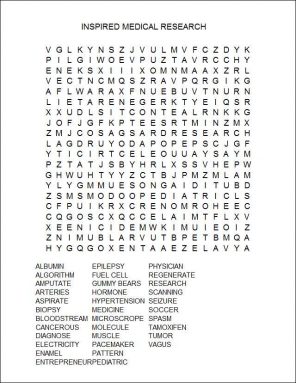Inspired medical research
Teens make real advances in biomedical science
Share this:
- Share via email (Opens in new window) Email
- Click to share on Facebook (Opens in new window) Facebook
- Click to share on X (Opens in new window) X
- Click to share on Pinterest (Opens in new window) Pinterest
- Click to share on Reddit (Opens in new window) Reddit
- Share to Google Classroom (Opens in new window) Google Classroom
- Click to print (Opens in new window) Print
By Kellyn Betts
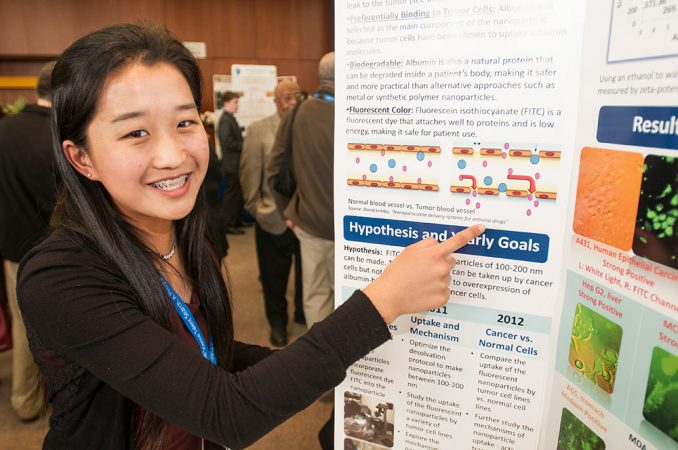
Kelly Xinyi Zhang, 17, has been aware of cancer and its effects almost her entire life. When she was just 5, a friend developed bone cancer. Doctors amputated part of the girl’s leg, saving her life. Later, when Zhang was in middle school, the father of another friend was diagnosed with colon cancer. Surgeons tried but could not remove all of the cancer. Two years ago, he died.
People often find inspiration in such tragic and personal events. A few may even begin doing research while still students — investigations that some day might save lives. Zhang, who attends College Preparatory School near her home in Orinda, Calif., is among those. Her experience with cancer inspired her to improve an inexpensive way to diagnose the disease.
Eventually, this advance could help doctors better tell cancerous cells from healthy ones during surgery. The development earned the teen a finalist’s spot in the March 2012 Intel Science Talent Search (STS). The Society for Science & the Public, publisher of Science News for Kids, developed and runs the premier research competition for students in their last year of high school.
In recent years, about one-third of all Intel STS finalists performed research in areas related to medicine. Here, we profile seven of this year’s competitors. All of them are making important strides to improve health.
Glowing cancer cells
Zhang’s discovery takes advantage of the tendency of cancer cells to accumulate a protein called albumin. Albumin occurs naturally in blood.
The teen added a glowing dye to tiny particles, which she then mixed with albumin. This two-step process produced particles small enough to seep out from a patient’s blood and into any cancer cells. The dyed particles also make cancer cells glow when viewed under a microscope.
Zhang tested her glowing particles at a drug research laboratory run by the University of the Pacific. She used two types of normal cells and eight types of cancer cells. Because cancer cells took up more of the dyed albumin, they glowed more brightly than healthy cells did.
Physicians may one day inject these dyed particles into the bloodstream of cancer patients before surgery. Using a special camera, surgeons then could identify and remove only the cancerous tumor, since its cells would glow most visibly.
Grin science
The tumor that spurred Stephen Adam Le Breton, of Greenwich, Conn., to pursue medical research was more personal. It affected his leg. The good news: His tumor was not cancerous.
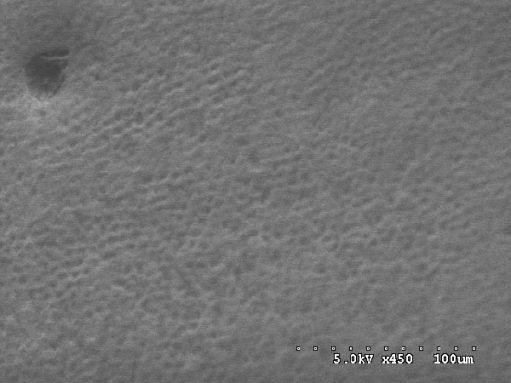
Doctors found the growth when Le Breton was in 7th grade. To remove the tumor, surgeons also had to take out a piece of the boy’s right tibia, the bone below the knee. The lost bone grew back quickly. “I was surprised by how fast,” Le Breton says.
Today, at 17, both of his legs are healthy and work fine. That’s fortunate because he rows crew, scuba dives and runs his own lifeguarding business.
Le Breton also has been busy studying when bone regenerates — and doesn’t. Usually this research would require studying changes within living people. But that was not allowed in Le Breton’s 11th grade research class at Greenwich High School. His compromise? Focus on teeth extracted from dental patients. (Although teeth are not technically bones, they share many similarities with bone.)
In the last 18 months, Le Breton has learned a lot about teeth (including how badly they can stink while sawing them in half). The outer portions of teeth are made of enamel. It is the hardest substance in the human body. Unlike bone tissue, which can regrow, tooth enamel doesn’t. Over time, some share of everyone’s tooth enamel will wear off. That can lead to decay.
To repair the wear and tear, Chinese researchers have created an artificial enamel. But adhering it to teeth takes a day. It also uses chemicals that can be toxic. Le Breton figured out how to refine the method and make the synthetic enamel more quickly. His process also should be safer.
Le Breton embedded the ingredients for the synthetic enamel into a soft polymer, or plasticlike material. The teen shapes the polymer into a tray that fits around someone’s teeth. This limits exposing anything other than teeth to the chemicals. Moisture in the mouth then triggers the polymer to slowly release the synthetic enamel’s ingredients.
Le Breton tested the system on about 50 teeth that local oral surgeons had pulled. Then the teen went to a local research facility, where he used a scanning electron microscope to observe how well the synthetic enamel bound to teeth. The microscope can magnify a sample up to one million times. This confirmed that his enamel coating bonded tightly to the teeth.
One day, if you’re unlucky enough to need the enamel on your own worn teeth repaired, Le Breton’s discovery may provide just the right fix.
Power for miniature robots
Another innovative fix for ailing bodies may come from Raja Selvakumar, 17. He is helping bring about a future where robots the size of gummy bears perform life-saving surgery.
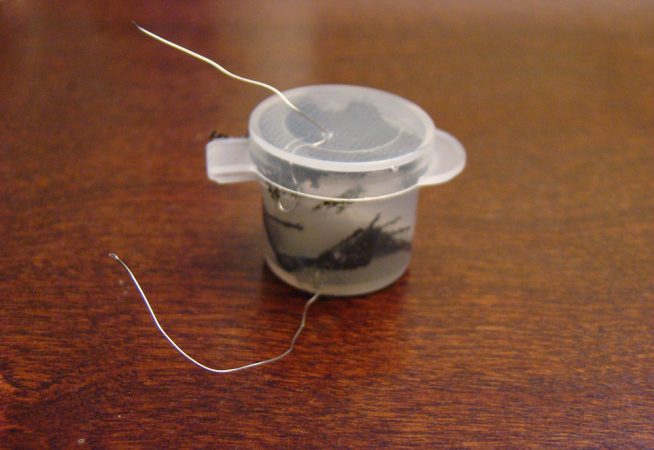
While a 10th-grader at Milton High School, near his home in Alpharetta, Ga., Selvakumar read how scientists had already created some of the mini robots. However, without an efficient way to power them, they would likely never fulfill their promise, according to the article. Selvakumar thought he might have a solution.
A year earlier, the teen had created a microbial fuel cell. It uses yeast and sugar to make electricity. Selvakumar wondered whether this technology might be able to power the tiny surgical robots as they worked inside the body.
Within a few months, he had drawn up plans for a device that would use bacteria living in stomach acid to produce electricity. These germs could provide an essentially inexhaustible source of power. The teen perfected and tested his first device at nearby Emory University. Since then, he has focused on shrinking it. The latest version is about 2 centimeters (0.75 inch) tall and 2.4 centimeters across. It steadily generates a relatively high voltage (700 millivolts). This provides the constant supply of power the tiny robots will need.
Up next: Shrinking the fuel cell to one-fourth its current size so that it can fit inside a 2-centimeter tall robot. No sweat. Raja says he “is very confident that it can be done.”
Brain inspired
When the student researchers profiled in this story do work up a sweat, it’s often while playing sports. In middle school, Brittany Michelle Wenger’s favorite sport was soccer. She was such an avid fan she created a computer program that let her play even when off of the field. In 10th grade, she developed a more complex computer program. But this was no game. It focused on cancer cells.
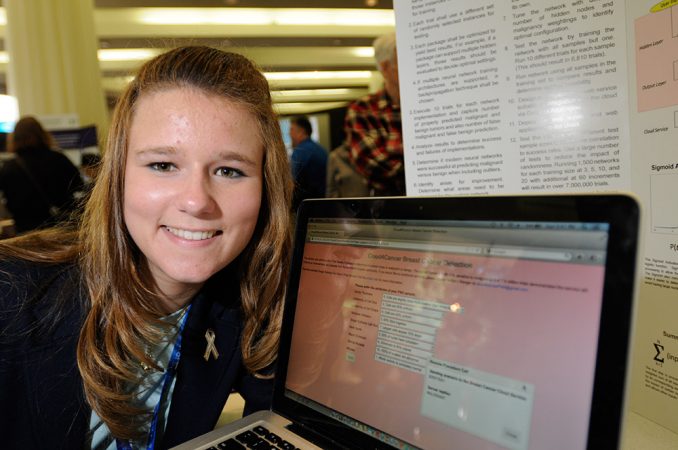
Like so many other medical researchers, Wenger’s inspiration was personal. A cousin had to undergo painful tests before confirming she had breast cancer. Troubled by what her cousin went through, Wenger learned about an easier and less painful test to diagnose the disease. Doctors use a very thin needle to aspirate — or suck out — a tiny quantity of fluid or cells. Doctors can then analyze these samples for signs of cancer. This diagnostic procedure is known as a biopsy. The only catch is that even experts have a hard time identifying cancer based on such tiny samples.
Wenger already was adept at creating computer programs to help in making difficult decisions. Like the brain, her programs excel at finding patterns in data. They also can adapt and change as they learn. Based on their brainlike approach to making decisions, such programs are known as artificial neural networks.
The 18-year-old student at The Out-of-Door Academy in Sarasota, Fla., trained an artificial neural network to interpret the results of fine-needle biopsies based on what doctors do. The process involves creating 10 different neural networks. Each learns a little differently. Using cells contributed by hospitals, Wenger asked her networks to determine whether those cells were healthy or cancerous.
Doctors don’t tell the model which features of any one biopsy are most important. Wenger doesn’t either. “I let the computer use its own brain to figure that out,” she says. So far, the program has been identifying cancer correctly 99 percent of the time. It shows so much promise that the teen now hopes to patent it.
On March 12, Wenger’s program won the young computer scientist eighth place — and a $20,000 prize — at the 2013 Intel STS competition. (All finalists mentioned in this story received prizes valued at a minimum of $7,500.) And more good news: Wenger’s cousin is doing quite well.
Block that call
Unfortunately, cancer remains a leading cause of death. Cancers that struck friends and one family member left a deep impression on Jennifer Chan, 18. So last year when this student at the Academy for Medical Science Technology in Hackensack, N.J., was hunting for a meaningful research project, she picked breast cancer.
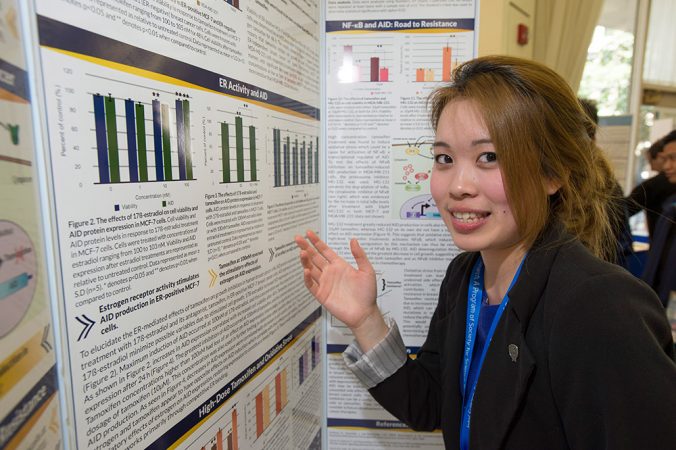
For years, tamoxifen has been a common treatment for many breast cancers. This synthetic hormone resembles estrogen, a female sex hormone. Estrogen can promote the growth of some cancer cells. Tamoxifen works by latching onto those cells. That blocks any estrogen from binding, leaving the cells to starve. However, high doses of tamoxifen can trigger breast cancer cells to release chemicals that signal they are under assault. Afterward, the body no longer fights the cancer effectively. Chan decided to see if she could mute that stress call.
One chemical in the stress call is an enzyme that can alter the body’s genes. Chan found a way to block the enzyme. And it did mute the stress call. It also cut the cancer’s growth rate, Chan showed. One day, her finding might boost tamoxifen’s effectiveness in treating breast cancer.
Beyond cancer
Many teen researchers draw on their own experiences receiving medical treatment, and not just for cancer. For example, Jack Ryan Takahashi, 17, developed an interest in medicine during middle school. That’s when he underwent a lengthy experimental procedure to correct a chest deformity. The time spent in hospitals and around doctors “showed me how interesting working in medicine can be,” he recalls.
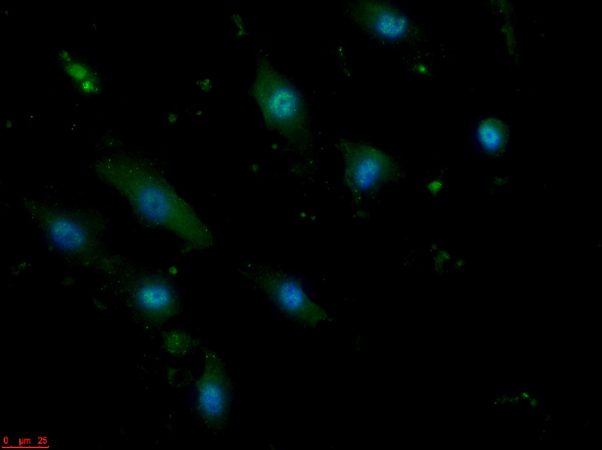
Today, Takahashi attends Lynbrook High School near his home in Saratoga, Calif. He is probing a rare disease of the heart and lungs called pulmonary hypertension (PULL ma NAIR ee HY per TEN shun). An overgrowth of cells can stiffen the pulmonary arteries, or the blood vessels that link the heart to the lungs. That stiffening makes it harder for the heart to push blood through the vessels. As a result, people with the disease develop very high blood pressure. Untreated, the disease weakens the right side of the heart. Eventually it can fail. This disease can strike people of all ages and ethnic backgrounds.
Through his research, Takahashi discovered unusually high levels of a protein in the cells of arteries affected by this disease. The protein is a signaling molecule. It can control how certain cells respond, sometimes signaling them to grow more than they should. Takahashi hopes other scientists can build on his findings to make a drug that targets the protein. That could keep it from impairing the growth of the arteries.
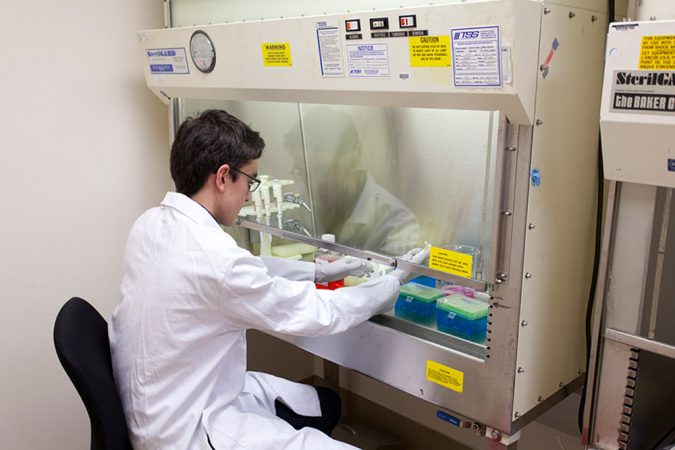
Before the storm
Akshay Padmanabha, 16, was also drawn to medical research by his own health. In grade school, he developed a “tic.” Even now, he can temporarily lose control of the muscles around his eyes. When this happens, he briefly blinks shut one or both eyes. You might not even notice his doing it, but it can happen a few times per minute. Scientists don’t know exactly what in the brain causes the problem. And there is no cure.
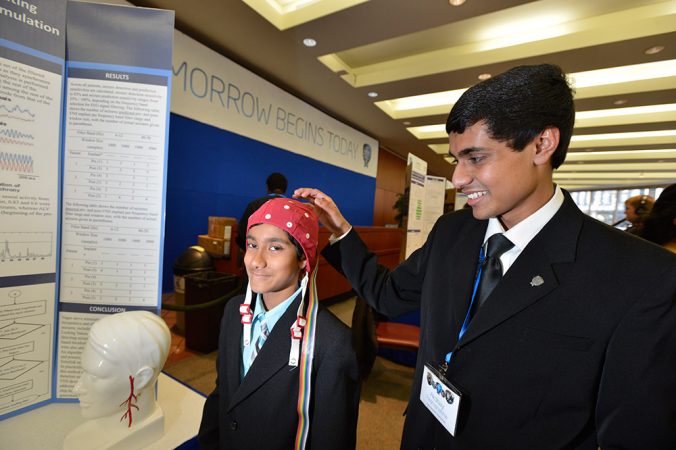
The tic sparked Padmanabha’s curiosity about the nervous system and how to measure its activity. Ever since 10th grade at Houston High School, in Collierville, Tenn., this teen has been doing research at the nearby University of Memphis. There, he analyzes electrical activity in people’s brains. To do so, he relies in part on a technique known as an EEG, short for electroencephalography (ee LEK troh en SEF ehh low GRAH fee). EEGs chart electrical storms within the brain that are associated with the sudden attacks or spasms known as seizures. (Padmanabha had an EEG done on himself! It can hurt a bit at first, he notes.)
The teen uncovered electrical changes, or patterns, that predict oncoming seizures. He then developed a series of mathematical steps, called an algorithm, to scout for these patterns. One day, his algorithm could allow a patient to take action and prevent an oncoming seizure. Padmanabha is currently programming the algorithm’s pattern-recognition ability into a computer chip. That way, it could be implanted into the body.
The teen’s discovery might one day help people with epilepsy, a major cause of seizures. Some epileptics wear a device implanted near the collar bone. It’s known as a vagus nerve stimulator. By delivering a low-voltage electrical signal, this implant can reduce the risk of seizure.
It works by emitting regular pulses of electricity, much like a heart pacemaker does. Unfortunately, that implant comes with side effects, including trouble sleeping and even heart attacks. However, a stimulator programmed with Padmanabha’s algorithm would send out electrical pulses only when a seizure was on its way. That should reduce those side effects — an impressive benefit.
How impressive? The project won Padmanabha 9th place — and a $20,000 prize — in the 2013 Intel STS competition.
The researchers profiled here will all continue to make an impact as they head to college and beyond. Chan and Zhang hope to pursue careers in medicine. So do Le Breton, as a military physician, and Wenger, as a pediatric cancer doctor. Padmanabha plans to continue studying the brain. Takahashi is currently leaning toward medical research too. And Selvakumar wants to become an international entrepreneur, or someone who creates or operates a business. Stay tuned!
Power words
albumin A protein found in human blood that helps transport different small molecules. Many foods — including eggs and milk — also contain albumin.
benign Not harmful to one’s health. Malignant, in contrast, means harmful and generally refers to cancer.
biopsy The removal and examination of a small sample of tissue to discover the presence, cause or extent of a disease, including cancer.
algorithm A step-by-step method for solving a problem or accomplishing a goal.
electroencephalography (EEG) A charting of the electrical activity in the brain.
electron microscope A microscope with high resolution and magnification that uses electrons rather than light to image an object.
enamel The glossy, hard substance that covers a tooth.
fine needle aspiration A diagnostic test that uses a thin needle to extract a tiny amount of tissue or fluid from a patient. The extracted cells can reveal the changes that mark the development of cancer.
microbial fuel cell A device that generates electricity by using microbes to help initiate a chemical reaction.
neural network A computer program designed to work in a way similar to the human brain. The programs can “learn” from examples, just as the brain does.
polymer A large molecule composed of repeating structural units. Examples include different kinds of plastic, Silly Putty and cellulose (a main component of wood and paper).
pulmonary hypertension A rare disease that causes abnormal growth of the blood vessels that connect the heart to the lungs. The disease leads to very high blood pressure and forces the right side of the heart to work harder than normal.
seizure A sudden attack or spasm caused by abnormal electrical activity in the brain.
tamoxifen A drug used to treat certain types of breast cancer.
Word Find (click here to print puzzle)
